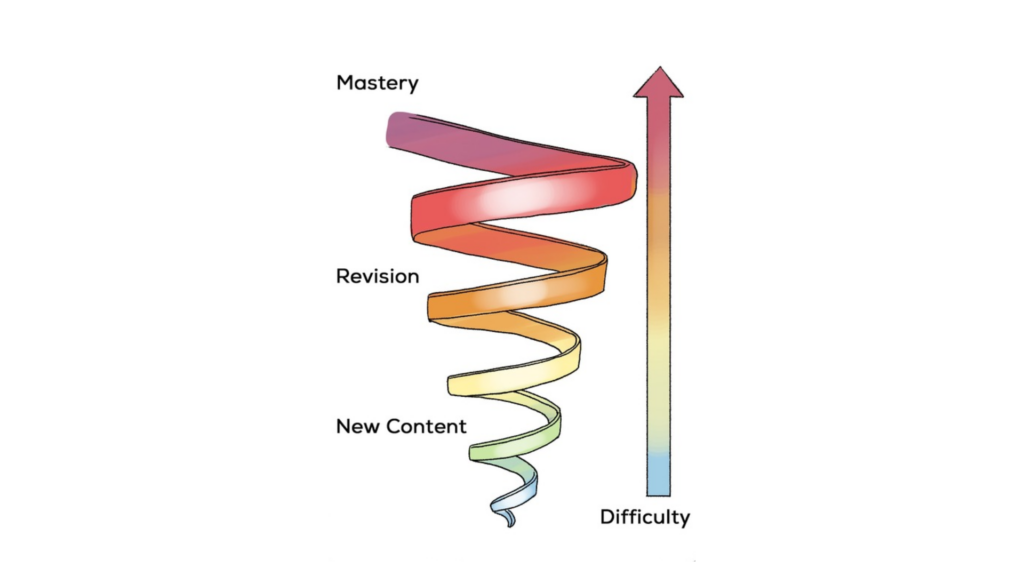
Why a Spiral Curriculum Is Essential for Your Child’s Success in ELA
When it comes to homeschooling English Language Arts (ELA), the right approach can make all the difference in your child’s understanding, retention, and long-term mastery of writing and literacy. One of the most effective and research-backed methods for teaching ELA is the spiral curriculum, an approach that builds skills over time through repeated exposure, deepens complexity at each stage, and strengthens retention through ongoing reinforcement.
If your child has ever struggled with retaining writing skills, grammar rules, or comprehension strategies, a spiral approach may be exactly what they need to flourish as a writer and critical thinker.
What Is a Spiral Curriculum?
A spiral curriculum is designed to introduce, revisit, and reinforce key concepts over time instead of teaching a topic once and moving on. This method allows students to:
✔ Receive repeated exposure to core ELA concepts.
✔ Increase depth and complexity as they grow.
✔ Learn through strategic repetition, ensuring long-term comprehension and mastery.
Unlike traditional linear curriculums that teach a skill once and assume mastery, a spiral curriculum cycles through essential skills repeatedly, giving students multiple opportunities to refine and strengthen their abilities.
Why a Spiral Curriculum Is the Best ELA Homeschooling Style
1. Repeated Exposure Strengthens Mastery
One of the biggest challenges in learning writing, grammar, and reading comprehension is that students often forget material if they don’t revisit it regularly.
A spiral curriculum ensures that students encounter the same concepts multiple times throughout their academic journey, reinforcing their understanding and eliminating gaps in learning.
❌ Traditional, one-and-done curriculums assume mastery after a single lesson, which often leads to students forgetting key skills.
✅ A spiral approach ensures concepts are reinforced naturally, leading to mastery over time.
2. Deepens Complexity Without Overwhelming Students
Students aren’t meant to master everything all at once—true learning happens when they are given time to process and apply knowledge in different contexts.
A spiral curriculum introduces foundational concepts at an age-appropriate level, then revisits them later with increased depth and complexity.
For example, in an ELA spiral curriculum:
- Younger students may begin by identifying the basic structure of a sentence.
- Later, they’ll revisit sentence structure in more depth, learning about different types of clauses and sentence variation.
- As they grow, they’ll refine their skills by applying them in essays, creative writing, and advanced composition.
This ensures that students don’t just memorize rules—they truly understand and apply them.
3. Enhances Long-Term Retention Through Repetition
Many students struggle with retaining grammar rules, vocabulary, and writing skills because traditional programs teach once and move on. However, research shows that repetition is key to memory and skill-building.
With a spiral curriculum:
✔ Students revisit core ELA skills at regular intervals.
✔ They have multiple opportunities to refine their writing techniques.
✔ They gain confidence as their understanding grows naturally over time.
By cycling through writing, grammar, and comprehension lessons in a structured, repeated way, students retain knowledge better and apply their learning more effectively.
4. Provides a Stronger Foundation for Advanced Learning
Many students hit a wall in writing because they lack a strong foundation in earlier skills. This is especially common in rigid, linear curriculums, where students are expected to master writing, grammar, and composition in a short timeframe without consistent reinforcement.
A spiral curriculum prevents learning gaps by ensuring that no student moves forward without fully understanding foundational concepts. By constantly revisiting, refining, and strengthening skills, students are better prepared for advanced writing, literature analysis, and higher-level academic work.
✅ A strong foundation in writing and reading leads to success in every academic subject.
Why Essentials in Writing Uses a Spiral Curriculum
At Essentials in Writing (EIW), we believe that a spiral approach is the best way to teach ELA. Our curriculum is structured to introduce writing concepts at a foundational level and gradually build upon them as students grow.
✔ Step-by-step video lessons guide students through each concept.
✔ Writing, grammar, and reading comprehension are revisited and reinforced at multiple levels.
✔ Students progress at their own pace, mastering skills over time.
✔ Short, focused lessons keep students engaged and reduce overwhelm.
With EIW’s spiral curriculum, your child will develop strong writing skills, grammar comprehension, and critical thinking abilities that will serve them for a lifetime.
Switch to a Proven ELA Method and Save 25%!
A failing curriculum steals your child’s potential by forcing them into rigid, ineffective learning structures. Instead of struggling with confusing, disjointed lessons, give them the structured, research-backed spiral approach that actually works.
💡 Right now, you can switch to Essentials in Writing and save 25% with code “SPRINGCHANGE”!
👉 Take control of your child’s education today—explore Essentials in Writing and see the difference a spiral curriculum makes!




